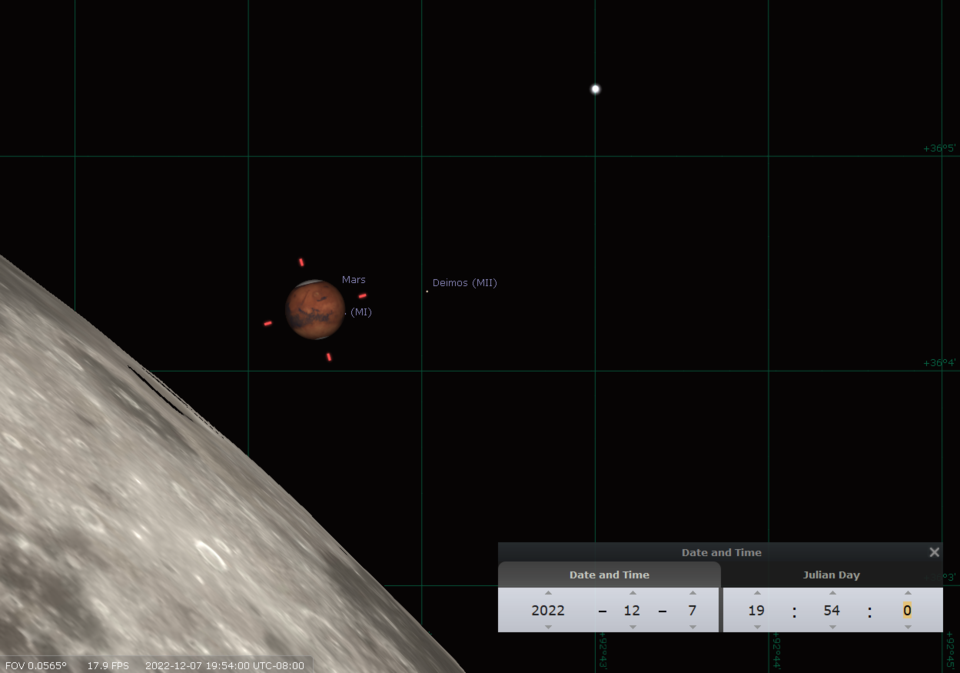For September, we have excellent opportunities to view the outer visible planets – Saturn, Jupiter and Mars – as well as views of Venus as it disappears around the Sun before its superior conjunction (on the far side) with the Sun on October 22. It will be visible before sunrise just above the eastern horizon for the first 10 days of September and vanish in the sunrise glare by about 0600. Our other inner neighbour, Mercury, is far enough east of the Sun to be visible in the evening but its location on the ecliptic puts it below the horizon just about the same time as the Sun sets. We’ll have to wait until early October to see Mercury again and then it will be briefly visible low in the SE before sunrise.
Saturn was at opposition (opposite the Sun) on August 14 and has been rising in the east each night just after sunset about five minutes earlier each night. The stars, however, which are for our intents fixed, only move about a degree per day relative to us as we orbit the Sun (actually 360 / (365 + 1) = 0.98 degrees per day) for 3.93 minutes per day.
So, if all the planets orbit the Sun in the same direction as we do, they should all be moving east with respect to the fixed background stars, right? Well, they do, at least if you look at them from a fixed position, like the Sun. But if you’re looking at them from another moving planet like Earth, we’re closer to the sun and moving faster than Saturn. That’s why Saturn appears to be moving backwards – to the west – relative to the stars! The normal motion to the east is named ‘prograde’ and to the west is known as ‘retrograde’. This periodic loop that the planets appear to undergo was a major bug in the Ptolemaic Earth-centric model of the solar system requiring “epicycles” for each planet to explain. Brahe, Kepler, Copernicus and Galileo did us all a favour by proving this was hooey and the heliocentric model explained it all without the nonsense.
Jupiter rises shortly after sunset each day, about 2100 on September 1 and just after 1900 by month-end. This pronounced early-rising is caused by two things: earlier sunsets and because Jupiter is in retrograde motion – even more pronounced than Saturn’s because it’s closer to us. It reaches opposition on September 26, but any time is ideal to see its four big moons looping around the giant planet. These are visible even with binoculars as long as you can steady them enough, although a telescope is ideal. Stellarium will show the moons’ positions in real time.
Mars is also getting brighter every night in September. It begins the month rising in the ENE just before midnight above the bright star Aldebaran in Taurus. While Aldebaran is 0.85 magnitude, Mars is brighter and redder at -0.15 magnitude. Yeah, I know, the brighter object has a lower magnitude, which doesn’t make sense. Blame the Greeks, not me; I suppose it seemed like a good idea at the time. Regardless, Mars is scooting along in a prograde direction about 90 degrees west of the Sun with us catching up from behind. By the end of September, Mars will have moved eastwards about half the distance across the top of Orion and will have brightened to about -0.61 magnitude. By the end of October, it will have moved about 15 degrees east of Aldebaran before coming to a stop and its magnitude will have brightened to -1.2. After that, Mars starts retrograde motion and just keeps getting better through November before its December 7 opposition at -1.87 magnitude. The Stellarium screenshot shows an interesting conjunction for that date – more on that later.
Finally, September is a great time to see the International Space Station; at the start of the month it will be morning passes, switching over to evening passes by mid-month. I’ve found that being able to point it out to kids (and occasionally adults) at star parties or wherever is a real attention-grabber. Many people know that Canada’s Chris Hadfield was the Station commander for some months on his 2012 – 2013 tour there and he also recorded an album in space. What most folks don’t know is that both he and I applied to the CSA in February 1992 and now I wish I’d taken up the guitar instead of the piano. I’m pretty sure it was the launch weight penalty for a baby grand that convinced them to pick Chris; I’ll stick with that excuse, thanks.
The SCAC will be setting up at the Harvest Festival on September 4 at the Botanical Gardens (details online) and the September meeting open to the public will be at the Sechelt Library at 1900 with the lecture topic being “Hunting for Meteorites”.
Please check the Sunshine Coast Club website at https://sunshinecoastastronomy.wordpress.com/ for updates. Also download Stellarium for any kids showing an interest in astronomy.



